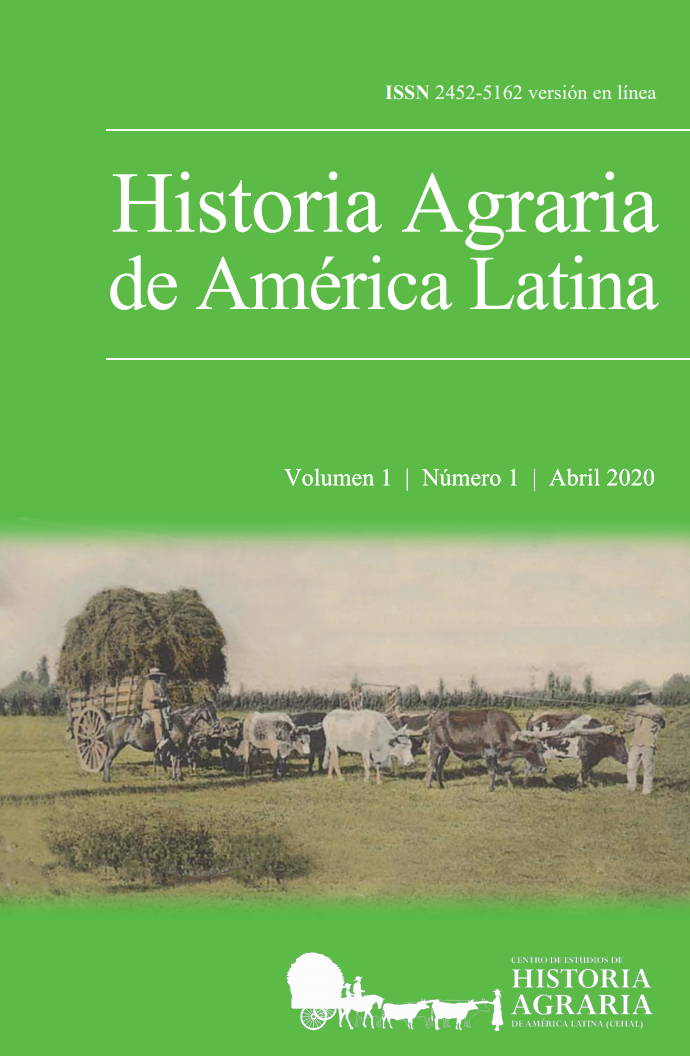Land and Labor Relations in Guatemala’s 1952 Agrarian Reform: Rethinking Rural Identities
- agrarian reform,
- rural politics,
- Guatemala,
- campesinos,
- local history
Vistas al resumen: 952 | Descargas: 2747
Resumen
This article explores local histories of Guatemala’s 1952 agrarian reform in the department of Sacatepéquez. It argues that applications of the land reform law were situated within a preexisting context of local rivalries rooted in conceptions of identity that were tied to community, land, and labor. By analyzing the way that individuals interacted with the agrarian reform and each other, this article also suggests that oversimplified understandings of Guatemala’s rural population tend to minimize the contested nature of agrarian reform. Instead, this article closely examines local politics in order to understand how involved individuals deployed social categories in pursuit of land.
Cómo citar
Derechos de autor 2020 Historia Agraria de América Latina

Esta obra está bajo una licencia internacional Creative Commons Atribución-NoComercial-SinDerivadas 4.0.
Citas
- Adams, Richard N. (2010). “Social Anthropology in INCAP,” Food and Nutrition Bulletin. 31(1. pp.152-160.
- Boyer, Christopher H. (2003). Becoming Campesinos: Politics, Identity, and Agrarian Struggle in Postrevolutionary Michoacán, 1920-1935. Stanford: Stanford University Press.
- Buckley, Eve E. (2017). Technocrats and the Politics of Drought and Development in Twentieth-Century Brazil. Chapel Hill: University of North Carolina Press.
- Chassé, Patrick. (forthcoming 2020). “The Coastal Laboratory: Milpa, Conservation, and Agrarian Reform.” In Out of the Shadow: Revisiting the Revolution from Post-Peace Guatemala. (57-85). Edited by Julie Gibbings and Heather Vrana. Austin: The University of Texas Press.
- Cullather, Nick. (1999). Secret History: The CIA’s Classified Account of its Operations in Guatemala, 1952-1954. Stanford: Stanford University Press.
- Forster, Cindy. (2001). The Time of Freedom: Campesino Workers in Guatemala’s October Revolution. Pittsburgh: University of Pittsburgh Press.
- García Añoveros, Jesús M. (1987). La reforma agraria de Arbenz in Guatemala. Madrid: Ediciones Cultura Hispánica Instituto de Cooperación Iberoamericana.
- Gibbings, Julie. (forthcoming 2020). Our Time is Now: Race and Modernity in Postcolonial Guatemala. Cambridge: Cambridge University Press.
- Gleijesis, Piero. (1992). Shattered Hope: The Guatemalan Revolution and the United States, 1944-1954. Princeton: Princeton University Press.
- Goubaud Carrera, Antonio. (1946). “El grupo étnico indígena: criterios para su definición.” Boletín del Instituto Indigenista Nacional de Guatemala. 1(2-3), pp. 13-30.
- Gould, Jeffrey. (1990). To Lead as Equals: Rural Protest and Political Consciousness in Chinandega, Nicaragua, 1912-1979. Chapel Hill: The University of North Carolina Press.
- Grandin, Greg. (2011). The Last Colonial Massacre: Latin America in the Cold War. Updated edition. Chicago: The University of Chicago Press.
- Handy, Jim. (1994). Revolution in the Countryside: Rural Conflict and Agrarian Reform in Guatemala, 1944-1954. Chapel Hill: The University of North Carolina Press.
- Immerman, Richard H. (1982). The CIA in Guatemala: The Foreign Policy of Intervention. Austin: The University of Texas Press.
- Mendívar, Rafael. (1969). Reforma agraria: Guatemala, Bolivia, Cuba. San Salvador: Editorial Universitaria de El Salvador.
- Olsson, Tore C. (2017). Agrarian Crossings: Reformers and the Remaking of the US and Mexican Countryside. Princeton: Princeton University Press.
- Paredes Moreira, José Luis. (1963). Reforma agraria: una experiencia en Guatemala. Guatemala: Imprenta Universitaria.
- Paz Cárcamo, Guillermo. (1986). Guatemala: reforma agraria. Costa Rica: Editorial Universitaria Centroamericana.
- Schlesinger, Stephen and Stephen Kinzer. (2005). Bitter Fruit: The Story of the American Coup in Guatemala. Revised and expanded. Cambridge, MA: David Rockefeller Center for Latin American Studies.
- Wolfe, Mikael. (2017). Watering the Revolution: An Environmental and Technological History of Agrarian Reform in Mexico. Durham: Duke University Press.


